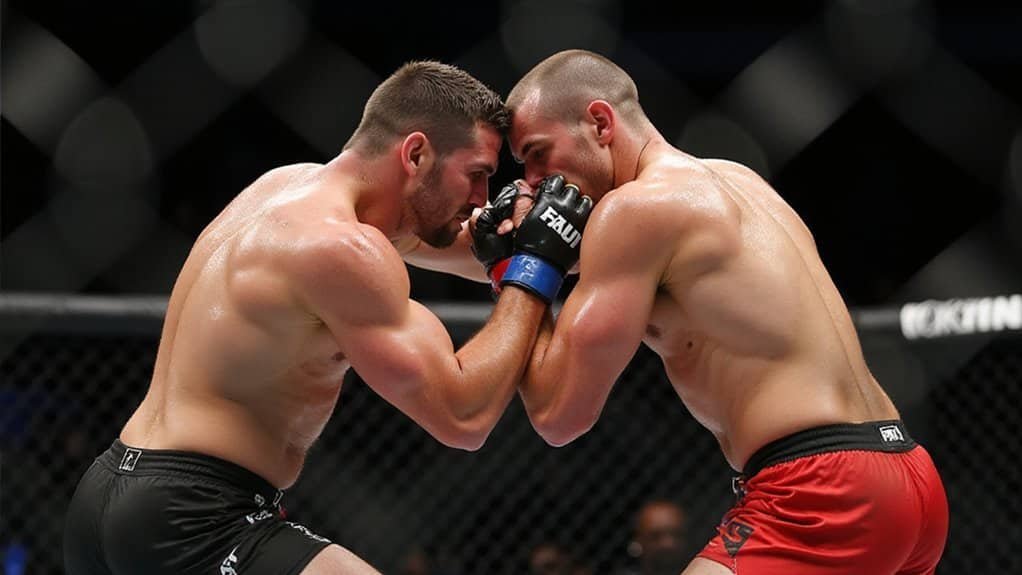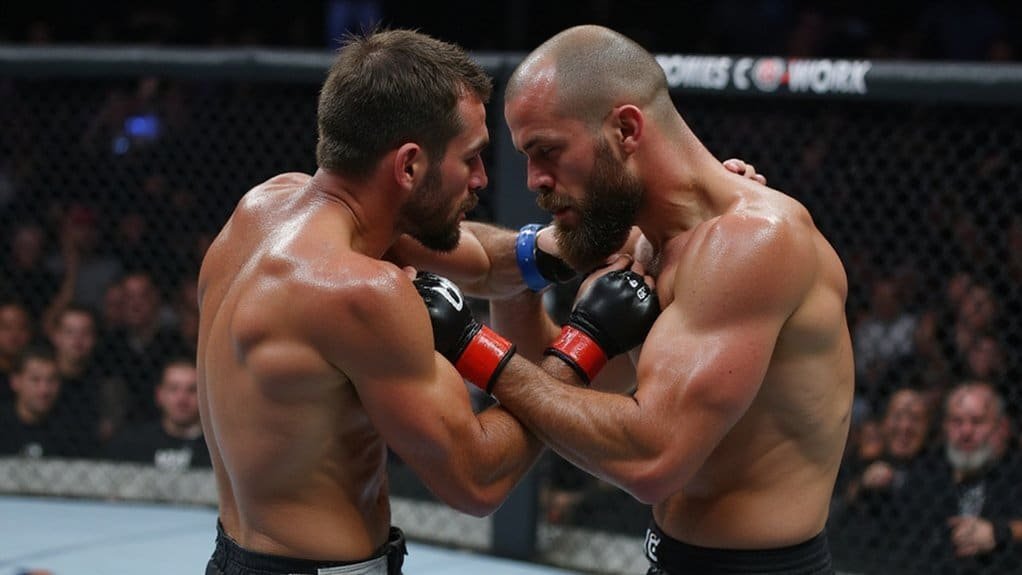The clinch in MMA is a standing grappling position where fighters engage at close range to control their opponent’s movement and striking capabilities. Common techniques include collar ties, double underhooks, and the Muay Thai “plum” grip, all of which are used for effective head control. Fighters use this position to launch knees, elbows, and short punches while setting up takedowns and throws. The clinch neutralizes range advantages and creates tactical opportunities that determine fight outcomes.

Two fighters lock horns in the center of the octagon, their arms intertwined as they jostle for position in what appears to be an awkward dance of control—this is the clinch, one of mixed martial arts‘ most underappreciated yet vital battlegrounds.
The clinch is a standing grappling position in which fighters control each other at close range, primarily while upright. This technique serves multiple purposes: it limits an opponent’s ability to strike effectively, creates opportunities for close-range attacks, and sets up takedowns. Far from being a stalling tactic, the clinch functions as both an offensive weapon and a defensive shield.
Mastering clinch positions requires understanding various grips and controls. Common techniques include the collar tie, double underhooks, body lock, and over-under positions. The Muay Thai clinch, featuring head and neck control known as the “plum,” enables devastating knee strikes. Arm placement proves critical—inside positioning provides tighter control and superior leverage over opponents.
Offensive applications from the clinch can inflict significant damage. Fighters deploy knees, elbows, short punches, and uppercuts while maintaining control. This “dirty boxing” approach combines traditional boxing techniques with grappling control to maintain continuous offense. Controlling an opponent’s posture limits their defensive options while exposing them to strikes. Breaking balance creates additional opportunities for both striking and takedowns. When executing knee strikes, the technique should touch the opposing leg while rising to maximize effectiveness.
Defensively, the clinch neutralizes an opponent’s range advantage, reducing the effectiveness of kicks and long punches. Proper posture and head position minimize vulnerability to counter-strikes and submissions. Controlling an opponent’s arms restricts their ability to break free or mount offense. Underhook dominance often determines who controls the exchange. The clinch becomes particularly strategic when pressed against the cage, where fighters can use the fence to leverage additional control and limit their opponent’s movement options.
The clinch serves as the primary setup for takedowns, enabling throws, trips, and body lock maneuvers. Greco-Roman wrestling influences upper-body takedowns, while judo throws and sweeps frequently initiate from standing clinch positions. Maintaining pressure can fatigue opponents and facilitate eventual takedown attempts. Successful clinch work requires keeping your head close to your opponent’s head to maintain control and minimize risks from strikes.
Submission opportunities exist but remain limited in standing clinch scenarios. The guillotine choke is the most common submission initiated from collar tie positions, where height advantages improve leverage. Other submissions, like arm triangles or rear-naked chokes, are possible but rare, typically requiring quick shifts to ground grappling for completion.
Understanding clinch work separates competent mixed martial artists from elite competitors. This position requires technical proficiency across multiple disciplines, including wrestling, Muay Thai, judo, and boxing.
Fighters who master clinch control gain a significant advantage in dictating the fight’s space, location, and outcome. The clinch transforms from an awkward entanglement into a sophisticated chess match where positioning, timing, and technique determine victory.
Frequently Asked Questions
How Do I Escape When My Opponent Has Me in a Clinch?
A fighter escapes clinches through three core methods: breaking grips, creating space, and countering offensively.
Pummeling arms inside the opponent’s hold establishes control, while hand fighting peels away dominant grips.
Framing with forearms against the collarbone creates separation. Ducking beneath arms or executing lateral footwork disengages pressure.
Short strikes like knees and elbows force opponents to release holds while maintaining defensive awareness against takedowns.
What Are the Most Common Injuries That Occur During Clinching Exchanges?
Head and neck injuries dominate clinching exchanges, with lacerations comprising 36-59% of all MMA injuries.
Concussions frequently occur from knees and elbows landing during close-range combat.
Knee injuries affect 30% of fighters annually, particularly MCL and LCL ligament damage from twisting motions.
Shoulder injuries impact 18% of athletes due to throws and joint manipulation.
Strains and sprains represent 32% of total injuries, mainly from clinch positioning battles.
How Much Training Time Should Beginners Dedicate to Practicing Clinch Work?
Beginners should dedicate at least one session weekly to clinch work, typically lasting 30-45 minutes.
This training integrates well with midweek wrestling or grappling sessions. Weekly programs should balance striking, ground work, and clinch practice to prevent overtraining.
Additional reinforcement occurs through situational sparring and live drills throughout the week. Consistent practice builds fundamental skills like balance, leverage, and position control essential for standing grappling proficiency.
Which Martial Arts Backgrounds Translate Best to Effective MMA Clinching?
Muay Thai and Greco-Roman wrestling provide the strongest foundations for MMA clinching.
Muay Thai’s specialized clinch techniques offer superior positioning, head control, and striking integration.
Greco-Roman wrestling emphasizes powerful upper-body throws and cage control, relying on upper-body attacks rather than lower-body movements.
Judo incorporates valuable grip fighting and momentum-based takedowns, while freestyle wrestling emphasizes hand fighting and defensive skills, albeit with a ground-focused approach that requires more adaptation.
What Conditioning Exercises Specifically Improve Clinch Strength and Endurance?
Effective clinch conditioning targets grip endurance, core stability, and functional strength patterns.
Chin-ups with towel grips simulate clinch hand dynamics while building pulling power.
Buzzsaw planks and anti-rotation exercises develop core strength against multidirectional forces.
Belt squat marches with medicine balls replicate knee strike mechanics under load.
Partner clinch rounds provide sport-specific endurance training that directly translates to live competition scenarios.

